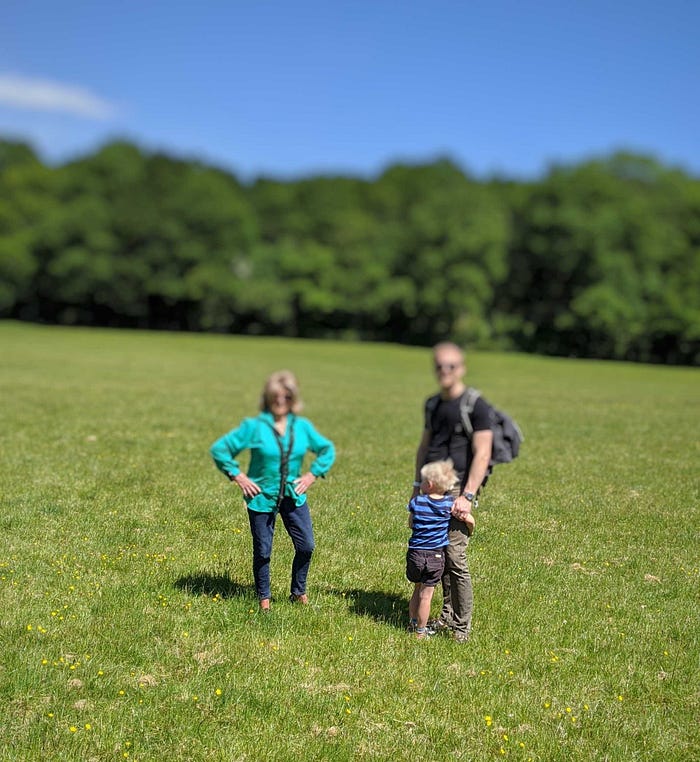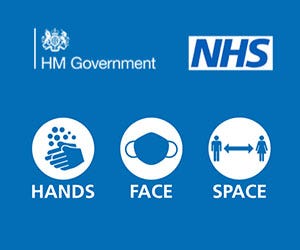The corrosive fear of asymptomatic transmission
There is a photo in my 2020 family album that I hate, it makes me shiver every time I come across it. On the face of it there is no reason to dislike it; the scene is bucolic. It is a sunny day in May, the trees are bright green, there are flowers in a meadow and my mum, my son and me stand looking at the camera, smiling. Then it becomes obvious why I hate it: the bizarre chasm between my mum and me tells the story; we were social distancing.
“nothing has left a more insidious and detrimental imprint on society than the combination of mask wearing and social distancing.”

A year on from the beginnings of the COVID crisis and nothing has left a more insidious and detrimental imprint on society than the combination of mask wearing and social distancing. As a human species these two actions go against 100s of thousands of years of evolution; we are engineered to see each others’ faces and to have contact. Just watch a wildlife documentary about a group of chimpanzees, or most primates for that matter; the amount of grooming and social contact is staggering. So it is no wonder that society has become a place of distrust, full of furtive glances, stretched friendships and spiralling mental health.
The bizzare thing is that it isn't COVID that has created this, though many would point to that as the blame. Rather it is the “hidden threat” of asymptomatic transmission that lies at the heart of the rupture in our social fabric. Early on there were studies done that suggested asymptomatic, or undocumented cases, were responsible for 85% of transmission in China. This study by Zhang et al, published in March 2020 was cited 723 times and relied heavily on modelling to reach its conclusion. Governments and health authorities rightly worried about this so “act like you have got it” became the mantra.
In the early phases of the virus this all made some sense; simple messages were required that could be adopted en masse and would help to prevent transmission. Given before all this, ie pre-2020, most people would not have thought twice about going to the office with a mild cold, potentially the symptoms of COVID for a large proportion of those infected, social distancing made plenty of sense. However our knowledge and understand has changed materially but the education hasn’t…this wouldn’t necessarily be a problem except for the fact that the two pillars for avoiding asymptomatic spread; masks and social distancing are totally toxic for a freedom loving society. Indeed in the UK, in contrast to the rest of Europe, one could argue a third, even more corrosive pillar has been built, school closures…

As a quick digression take hand washing and hygiene. It is now widely understood that surface transmission plays a very minimal role in transmission, if at all, indeed that was known by the summer last year. Yet in the UK “hands” remained the first part of a triumvirate of actions (hands, face, space) that was meant to control the spread (more on that later). The lack of hand shakes, and the emergence of the ‘Wuhan bump’ or fist bump, become par for the course. In schools and offices however this has led to a vast increase in the application and use of detergents. Perhaps no bad thing until you consider the implications from the increase in plastic packaging and environmental impact of boat loads of extra chemicals floating around.
So what do we now know about asymptomatic spread? In June last year the signs were already there that asymptomatic spread was likely to be much less of a factor than many thought. At a WHO press conference Dr Maria Kerkhove indicated that it was “very rare” based on a limited number of studies. This statement was quickly rowed back with the WHO clarifying that it didn’t want to downplay asymptomatic spread. It became such a contentious issue that Facebook and other platforms then started to label anything downplaying asymptomatic spread as misinformation. This Factcheck article on the whole Kerkhove situation is revealing as it states at the very beginning: “It is well documented that people without symptoms can transmit SARS-CoV-2, the virus that causes COVID-19” and goes on to say “Van Kerkhove’s initial summary also failed to include modeling studies that have found significantly higher contributions to transmission from people without symptoms”.
Therein lies the rub. The ‘well-documented’ mentioned above was based on papers that estimated spread via models, not from empirical evidence, which is what Kerkhove was quoting from. So what about now, over 6m on from that point? Here is a snippet from a recent BMJ editorial published in December which states that it is “unclear to what extent people with no symptoms transmit SARS-CoV-2” and goes on to state that transmission rates “maybe 3–25 times lower”, citing some studies.

Looking at those studies is revealing. For instance here is one of the largest meta-studies of household transmission rates, published in December and cited in the above article, that incorporates over 75,000 participants across 54 studies which found that the average secondary attack rate, or SAR, ie the probability that a close contact of someone testing positive gets infected, for symptomatic cases was 18%. So 17% of household contacts would go on to test positive for COVID. This compared to 0.7% of contacts who were asymptomatic.

Here is another more recent meta study published in January of 2021 which concludes that the chance of asymptomatic SAR is 1% vs 5–38% for symptomatic.

Reading around the subject it is clear that very few proper studies have been done to estimate asymptomatic spread and there are issues with many studies due to limitations around length of study period and testing methods. There are also issues with classification and follow up as to whether asymptomatic positives actually go on to develop symptoms.
Personally I find this staggering, why wouldn’t we want to be trying to understand and demystify something that is at the heart of much of the corrosion in our society and mental well-being. I think there are two reasons. The first is that governments most visible actions have all revolved around asymptomatic spread — mask wearing, social distancing, limitations on indoor meeting — and the second is that our society has become intolerant to risk. Therefore if there is a chance of asymptomatic transmission then we should err on the side of caution. Modelling of droplet and aerosol spread when talking for instance can show you that this is a “risk” and indeed some have genuinely advocated silence as a way of minimising spread, but at what cost to your own enjoyment and happiness.
In this context it isn't surprising that proper studies and analysis haven’t been undertaken because if you downplay asymptomatic spread you will be accused of indirectly killing people and worse, you will be undermining, the glue that binds people’s fear and allows for easier control. The trouble with the current view of eliminating risk is that it solely focuses on the risk of x right in front of you while ignoring all the negative consequences of those actions in the future, that could well manifest into a much bigger future risk.
I have some sympathy with those in power though because if you are faced with an antiquated health care system, one of the most overweight populations and rising cases, the need to be seen to be doing something must be all encompassing. However by making asymptomatic spread the bogeyman this has diverted attention from the real issues and causes of spread — namely underlying health (chiefly obesity), super spreaders and people continuing to go out and about with mild symptoms. My personal view is that education would have made all the difference and will be critical in repairing the damage done by a far too one-dimensional view of COVID transmission. A survey earlier this year for instance found that only 48% of adults seem to understand that the main way the virus spreads is, like most common respiratory diseases, via coughs/sneezes etc. More worrying was that 16% still think surface transmission is the most common method and 28% think it is just “floating in the air”.

It is therefore little wonder that cases can grow when the population has not been informed properly. The press also has a part to play by vilifying those not wearing masks or those not adhering to social distancing rules outdoors. Yes, these two things combined could be increasing risks but in reality it is negligible (outdoor transmission is effectively non-existent) and distracts from focusing on stopping the person who goes wandering around in public, wearing their mask coughing and spluttering. That person, who likely has poor social awareness and hygiene anyway, is case zero for superspreader events. Perhaps if the public were more aware that 80% of transmission comes from just 20% of cases they could become less fearful of each other overall but more focused on where to cast their disapproving glares in particular…
To conclude there is a desperate need to re-educate people as we emerge back into normal life; if you are well and healthy there is very little for you to fear. Just as going for a run can lead to a risk of a sprained or broken ankle, embracing a friend and having a dinner party can lead to a risk of transmitting an airborne infectious disease. ’Twas ever thus but we seemed to understand the benefits of the former hugely outweighed the potential risks.
